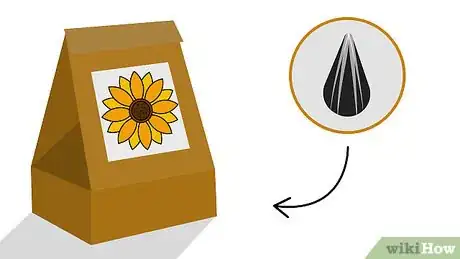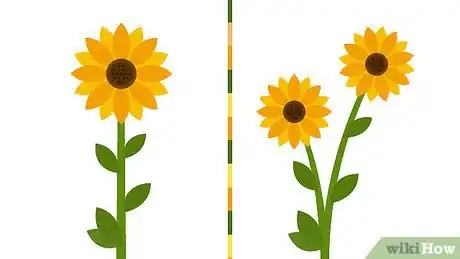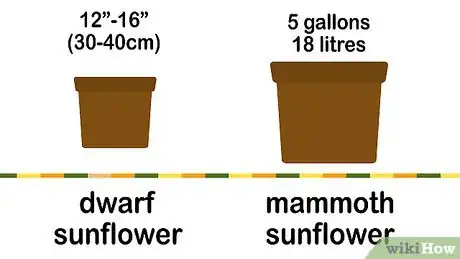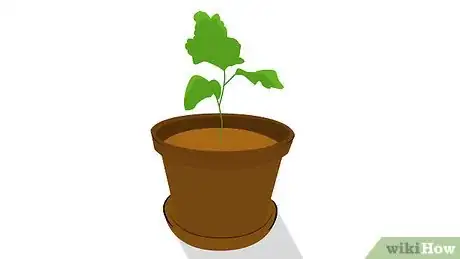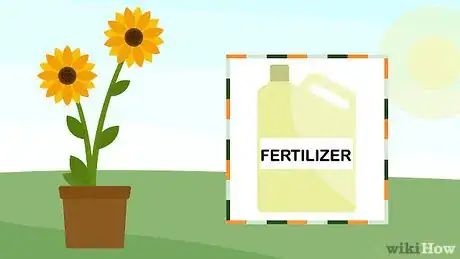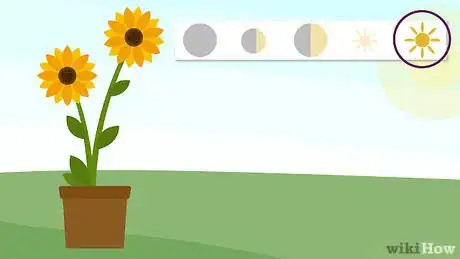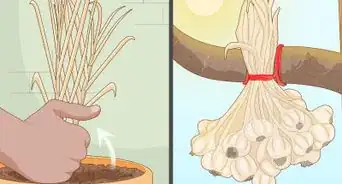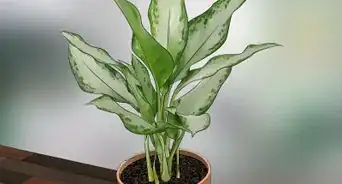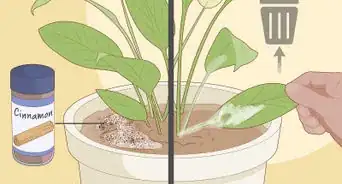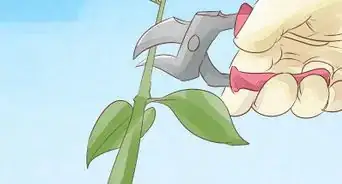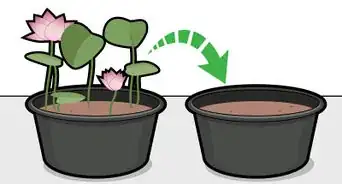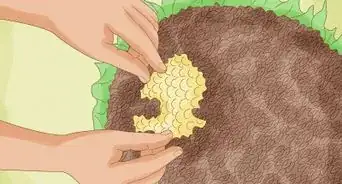This article was co-authored by Artemisia Nursery and by wikiHow staff writer, Jennifer Mueller, JD. Artemisia Nursery is a retail plant nursery in Northeast Los Angeles specializing in California native plants. Artemisia Nursery is a worker-owned small business with plans to become a worker-owned cooperative. In addition to California native plants, Artemisia Nursery offers a selection of succulents, heirloom veggie and herb starts, house plants, pottery, and gardening tools and supplies. Drawing on the knowledge of the founders, Artemisia Nursery also offers consultations, designs, and installations.
There are 12 references cited in this article, which can be found at the bottom of the page.
wikiHow marks an article as reader-approved once it receives enough positive feedback. This article received 22 testimonials and 85% of readers who voted found it helpful, earning it our reader-approved status.
This article has been viewed 1,198,920 times.
Sunflowers are native American plants with many uses. Their oil is used for biodiesel and cooking oil, and their seeds can make tasty snacks. A sunflower also makes a bright and happy addition to any sunny window or balcony. Growing a sunflower in a pot is an easy project that even small children can enjoy.[1]
Steps
Choosing Your Sunflower and Container
-
1Buy sunflower seeds for growing. You can buy sunflower seeds from your local nursery or garden center or order them online. If you want rarer varieties, you may have better luck online.[2]
- Sunflower seeds are also sold in grocery and convenience stores, but these are for eating, not for growing. After being roasted, a sunflower seed won't sprout.
- If you already have a fully grown sunflower plant, put the seeds from the flower in an airtight container and keep them in the fridge. Try to plant the seeds as soon as possible. Older seeds may be harder to grow.
- Pick a dwarf variety of sunflowers for best results, since larger varieties grow best in the ground.[3]
-
2Choose your sunflower variety. A packet of sunflower seeds (or a listing on a website) will clearly state the name of the variety, sunflower type, and how tall the sunflower will grow. If you're shopping at a local nursery or garden center, you can also ask an associate for help.[4]
- Single-stem sunflowers only grow one flower from one seed. If you want to keep sunflowers all summer, you'll have to replant every 10 to 14 days. However, single-stem varieties are pollen-less so that they won't drop pollen on your porch, furniture, or clothes.
- Branching sunflowers produce many flowers over the course of the season without having to be replanted. Branching sunflowers also have some of the more unusual colors, including burgundy and chocolate.
Advertisement -
3Find the right size container. Choose the size of your container based on the height of the flower you want to plant, as well as how many flowers you want in each container. Generally, most dwarf sunflowers can be planted in a 12 to 16 in (30 to 41 cm) pot.[5]
- Mammoth sunflowers need a container that holds at least 5 gallons (19 L).
- If you're repurposing a previously used container for something else, make sure it's clean and sterile. You may also have to make drainage holes in a repurposed container. Without them, your seeds may rot.
- Include a plate or saucer under the container to catch run-off water.
-
4Add potting soil and compost. Choose high-quality, nutrient-rich topsoil or potting soil to plant your sunflowers. Mixing in compost provides a source of food for your sunflowers as well.[6]
- Quality topsoil will have a pH of between 5.5 and 7.5 and have more than 3 percent organic content. These figures will be listed on the bag.[7]
- As long as you use high-quality topsoil, you don't need to add any drainage material, such as sand or rocks, to the bottom of the container. Doing so actually hinders water movement and can prevent your pot from draining properly.[8]
Planting Your Sunflower
-
1Push each seed about 1 inch (2.5 cm) into the soil. If you're planting more than one seed in your container, sow the seeds 4 to 5 inches (10 to 13 cm) apart. You may want to add a thin layer of compost to the top of the soil after your seeds are sown.[9]
- Make sure you have a radius of 4 to 5 inches (10 to 13 cm) around all sides of each seed. Don't show them too close to the edges of the container.
-
2Water the seeds daily. Sunflowers need more water than most plants as they are growing. Make sure the soil remains moist and well-drained. Give your sunflowers at least 2 gallons (7.6 L) of water a week while the seeds are germinating.[10]
- Sunflowers that don't get enough water during these early stages will have thin, weak stems that cannot hold the heavy flower head upright.
- Your soil is well-drained if water flows through it relatively quickly. Puddling or standing water in your pot indicates a drainage problem.[11]
-
3Watch as the seeds germinate. Within a week to 10 days, your sunflower seeds should start growing into small seedlings. During this time, continue to water the seeds every day and make sure the soil is moist, particularly around the seeds.[12]
- If your sunflowers are outside, you may want to cover the seedlings with baskets or netting to protect them from birds.
Caring for Your Sunflower
-
1Add fertilizer if desired. While sunflowers don't necessarily need additional feeding to grow, fertilizer can make the colors on your flower heads brighter and bolder. Start with a high-nitrogen liquid plant fertilizer, then switch to one with more phosphorus when the bud begins to bloom.[13]
- You can also add diluted fertilizer to your sunflower's water. Take care not to over-fertilize your sunflower – the stem may break.[14]
-
2Keep your sunflower in direct sunlight. As the seedlings grow, they need as much direct sunlight as possible so the stems will be thick and strong and able to support the large flower head. Once grown, your sunflower should have 6 to 8 hours of direct sunlight a day.[15]
- The heliotropic heads of sunflowers follow the path of the sun. If not in direct sunlight, they will bend towards the sun, damaging the stem over time.
-
3Water your sunflower several times a week. Expect to water your sunflowers more often than you do other plants. Check the soil every day or two – it should be constantly moist. Generally, give your sunflowers about 2 gallons (7.6 L) of water a week.[16]
- If your sunflowers are outside, they should be fine with rainwater after they reach 1 to 2 feet (0.30 to 0.61 m) in height.[17] You may need to compensate if you have a scorching, dry day.
- As the flower grows, water the root zone in a 3 to 4 in (7.6 to 10.2 cm) radius around the plant itself.[18]
- Keep a spray bottle handy and spritz the flower head with water regularly.
-
4Stake your sunflower if necessary. Some dwarf varieties may not grow tall enough to need support. However, if your sunflowers reach a height of 3 feet (0.91 m) or taller, they should be anchored to something to keep the flower head from drooping.[19]
- Don't anchor your support within the pot itself. When your sunflower reaches full size, it may tip the pot over. Tie the stake to a drainpipe, wall, or another object.
-
5Harvest the seeds. If you have a sunflower variety with edible seeds, let the flower die on the stem. The seeds will ripen and dry as well. If your sunflowers are outside, cover them with netting or a paper bag to keep the birds from eating all your seeds.[20]
- Generally, sunflower seeds that are black or gray with white stripes are edible.
- When the back of the flower head turns brown, the seeds are typically ready to harvest.[21]
- Once dried, you can keep the seeds in an air-tight container at room temperature for up to 4 months. You can also freeze them if you need them for longer.
- Sunflower buds can be eaten as well. Blanch them first to remove bitterness, then steam or boil them for 3 minutes. They are delicious tossed in garlic butter.
Expert Q&A
Did you know you can get premium answers for this article?
Unlock premium answers by supporting wikiHow
-
QuestionCan you grow tall sunflowers in a pot?
 Maggie MoranMaggie Moran is a Professional Gardener in Pennsylvania.
Maggie MoranMaggie Moran is a Professional Gardener in Pennsylvania.
Home & Garden Specialist
-
QuestionHow often should you water a potted sunflower?
 Maggie MoranMaggie Moran is a Professional Gardener in Pennsylvania.
Maggie MoranMaggie Moran is a Professional Gardener in Pennsylvania.
Home & Garden Specialist
-
QuestionCan you plant sunflowers in the shade?
 Maggie MoranMaggie Moran is a Professional Gardener in Pennsylvania.
Maggie MoranMaggie Moran is a Professional Gardener in Pennsylvania.
Home & Garden Specialist
Warnings
References
- ↑ https://plants.usda.gov/plantguide/pdf/cs_hean3.pdf
- ↑ http://www.johnnyseeds.com/growers-library/flowers/library-flowers-choose-sunflowers.html
- ↑ Artemisia Nursery. Plant Nursery & Garden Shop. Expert Interview. 7 August 2020.
- ↑ http://www.johnnyseeds.com/growers-library/flowers/library-flowers-choose-sunflowers.html
- ↑ http://www.gardeningblog.net/how-to-grow/sunflowers/
- ↑ http://www.gardeningblog.net/how-to-grow/sunflowers/
- ↑ https://ipm.missouri.edu/MEG/2009/9/Selecting-Good-Top-Soil-for-Lawns-and-Gardens/
- ↑ https://s3.wp.wsu.edu/uploads/sites/403/2015/03/container-drainage.pdf
- ↑ https://celebrateurbanbirds.org/learn/gardening/container-gardening/how-to-plant-sunflowers/
- ↑ https://www.americanmeadows.com/wildflower-seeds/sunflower-seeds/how-to-grow-sunflowers
- ↑ http://agebb.missouri.edu/agforest/archives/v10n2/gh14.htm
- ↑ https://celebrateurbanbirds.org/learn/gardening/container-gardening/how-to-plant-sunflowers/
- ↑ http://www.balconycontainergardening.com/plants/76-grow-care-sunflowers
- ↑ https://www.almanac.com/plant/sunflowers
- ↑ http://www.balconycontainergardening.com/plants/76-grow-care-sunflowers
- ↑ http://www.balconycontainergardening.com/plants/76-grow-care-sunflowers
- ↑ http://www.gardeningblog.net/how-to-grow/sunflowers/
- ↑ https://www.almanac.com/plant/sunflowers
- ↑ http://www.gardeningblog.net/how-to-grow/sunflowers/
- ↑ http://www.gardeningblog.net/how-to-grow/sunflowers/
- ↑ https://www.almanac.com/plant/sunflowers
- ↑ https://www.seedsavers.org/category/sunflowers
- ↑ http://www.gardeningblog.net/how-to-grow/sunflowers/
- ↑ http://www.gardeningblog.net/how-to-grow/sunflowers/
- ↑ http://www.gardeningblog.net/how-to-grow/sunflowers/
About This Article
To grow sunflowers in a pot, first get some dwarf sunflower seeds. Dwarf sunflowers grow well in pots since they don't get over 4 feet (1.2 meters) tall. Fill a 16 by 18 inch (40 by 45 cm) pot with topsoil that has a pH between 6 and 7. Mix a handful of compost into the soil to help your sunflowers grow faster. Then, push the seeds 1 inch (2.5 cm) beneath the surface of the soil with at least 4 inches (10 cm) between each seed. Place the pot in an indoor or outdoor spot that gets at least 6 hours of direct sunlight every day. Water the seeds every day to keep the soil moist. Your sunflowers should bloom in about 12 weeks. To learn how to care for your growing sunflower, scroll down!
